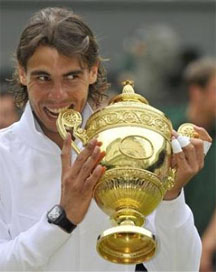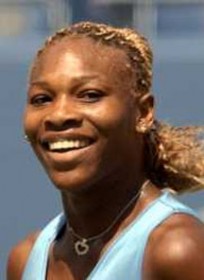LONDON, (Reuters) – A year that began with doubts over Rafael Nadal’s body and continued with worries over Roger Federer’s head ended with both men at the peak of their powers and promising some juicy new chapters of their rivalry in 2011.

The sight of the two greatest players of their generation jousting on opposite sides of the net at London’s O2 Arena as the men’s season came to a spectacular conclusion was a heart-warming one for fans the world over.
A paltry four meetings between the Spaniard and the Swiss in the past two years has left tennis followers feeling slightly short-changed but as the Australian Open looms both are eager to square off for the major prizes.
With Serbia’s Novak Djokovic, fresh from leading his country to a first Davis Cup title against France, British shot-maker Andy Murray and Sweden’s Robin Soderling posing genuine threats, the men’s game heads into the new year in rude health.
Shame then that the women’s game is in a state of flux.
Serena Williams won the 2010 Australian Open and then claimed a 13th grand slam title at Wimbledon before treading on broken glass in a Munich restaurant in July. She has not played since and the Tour needs her back.
Williams had been the dominant personality on the WTA Tour and her absence has left a vacuum that the new generation of baseline belters are not yet ready to fill.
Denmark’s 20-year-old Caroline Wozniacki ended the year as world number one almost by default. All eyes will be on her to win her maiden grand slam title in Australia where a still-struggling Williams will not be defending her crown.
Vera Zvonareva reached the Wimbledon and U.S. Open finals but the Russian world number two could walk through most city centres without attracting a second glance.
With Serena injured and sister Venus now the other side of 30, 2011 could be prime time for Belgians Kim Clijsters and Justine Henin to regain a stranglehold on the game.
RETIREMENT U-TURN
Clijsters retained the U.S. Open title she won the previous year months after returning to the Tour as a mother and Henin, who also made a retirement U-turn to rejoin the Tour in January, reached the Australian Open final, losing to Serena.
Henin was tipped to take the French Open by storm and win a fifth title at Roland Garros but crashed in the quarter-finals to Australia’s Samantha Stosur, her first defeat there since 2004.
Veteran Francesca Schiavone beat Stosur in a superb final to become, at nearly 30, the first Italian woman to win a grand slam singles title — stunning proof that women’s tennis is no longer a playground for teenagers.
Schiavone completed a memorable year by helping Italy to a third Fed Cup title in five years.

The men’s game is not flush with new faces either. There are no teenagers in the top 100 but, thankfully, the quality of the cream at the top persists. Nadal’s year was simply phenomenal.
After ending 2009 short of confidence and form, with concerns about his knees, the 24-year-old Mallorcan caught fire during the claycourt season and blazed a trail back to the top of the rankings in devastating fashion.
In March, he slipped to fourth in the rankings, then, in May, he snapped an 11-month title drought by winning the Monte Carlo Masters for a sixth consecutive time — demolishing Fernando Verdasco 6-0 6-1 in the final.Suddenly the demons vanished and he swept to victory in Rome and Madrid before regaining his French Open crown with an emotional win over Soderling at Roland Garros. Unstoppable, Nadal roared to a second Wimbledon title and then won the U.S. Open for the first time, beating Djokovic in the final.
In doing so he became the youngest man to win a career slam.
CONFIDENCE CRISIS
Nadal’s return to number one in the rankings coincided with Federer’s crisis of confidence.
The Swiss was overpowered by Soderling on a soggy claycourt in the quarter-finals of the French Open, ending a run of 23 consecutive grand slam semi-final appearances.
Worse was to follow.
At Wimbledon, scene of six of his 16 grand slam titles, he almost lost to Colombian firebrand Alejandro Falla in the first round. Trailing by two sets in front of a disbelieving Centre Court crowd, the Swiss was at 4-4 0-40 down in the third before somehow digging himself out of a hole. He admitted his escape was due to luck more than good play but there was no let-off in the quarter-finals when big-hitting Czech Tomas Berdych put him to the sword. “It took me a little bit to get over not regaining the Wimbledon crown, not being in the Wimbledon finals for I don’t even know how many years,” Federer said.
“That was a bit of a different feeling. But my feeling was always that I was going to come back strong after Wimbledon.”
Federer linked up with Paul Annacone, former coach of Pete Sampras and, while he lost to an inspired Djokovic in the U.S. Open semi-finals having missed two match points, he quickly rebounded to go 23-3 in the final months of the season.
“I think the men’s game is at an absolute high right now with a lot of exciting games being played, with a lot of respect,” Federer looking ahead to 2011.
“I think having had me and Rafa both making the career grand slam already at a young age is great for the game. We’re obviously playing not only for ourselves and beating the other guys, but also for history.”





